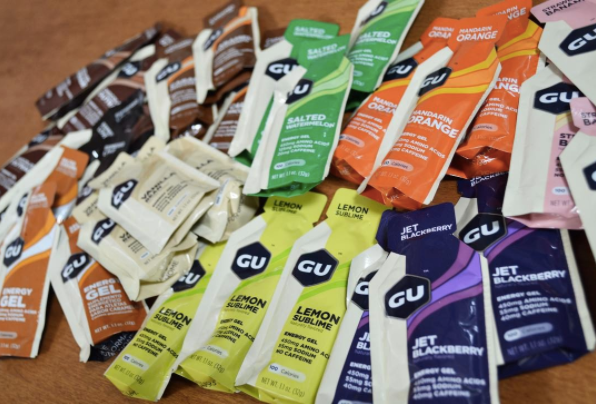New perk! Get after it with local recommendations just for you. Discover nearby events, routes out your door, and hidden gems when you sign up for the Local Running Drop.

Have you ever considered what’s really in that little plastic pouch? We enlisted the help of Kelly R. Jones, a Philadelphia-based registered dietitian and sports dietetics specialist, to help us break down the ingredient list in our fitness-friendly “snacks.” Here’s what we learned…
Gu Energy Gel
The purpose of a gel is to quickly get energy to your body’s systems, according to Gu spokesperson Brian Gillis. The brand is continually working to create new flavors, but salted caramel and chocolate are among the most popular.
It’s necessary to take at least three ounces of water with each packet, so you’ll need to plan your hydration along with your fueling. Jones says gels are especially good during endurance events, when you want to pack all of your nutrients into one product. The idea is to get in as many calories as you can handle every 30–45 minutes. That means for a 4-hour marathon you should try to down up to eight gels—although it takes a strong stomach and practice to handle that much.
What’s it made of?
Maltodextrin, fructose: Maltodextrin is a starch that breaks down rapidly into the simple sugar glucose. By having both fructose and glucose, which are absorbed differently, Jones says, you lessen stress on the gut. Also, the mix of carbs means a more consistent release into your bloodstream—and fewer energy spikes and drops.
Sea salt, potassium citrate, sodium citrate, calcium carbonate: These electrolytes replace what your body sweats out. The product focuses on delivering sodium, which is what we lose the most quickly.
Leucine, valine, histidine, isoleucine: These branched-chain amino acids (BCAAs) are four of the 20 building blocks of protein. BCAAs are more easily used for energy than other amino acids when carbohydrate stores in the body are low. Why would you want BCAAs? Jones says some research shows that having small amounts of BCAAs during endurance exercise can help reduce the risk of upper respiratory tract infections, which are common in endurance athletes post-marathon. Because protein is important to protect our immune system, if we start using our reserves as energy, it can compromise its immunity function. The regular Gu contains less than 1g of protein per packet, so ultra-marathoners may want to look at the Gu Rocktane, which has a full gram.